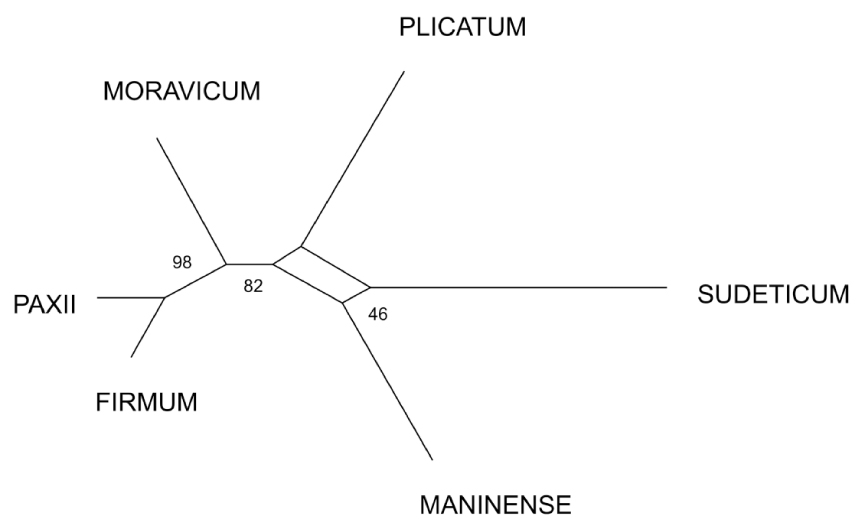Aconitum in Central Europe: from Linnaean taxonomy to molecular markers
Abstract
A role of the Linnaean taxonomy in the arising of historical-biogeographical hypotheses is envisioned. The first example concerns the presumed hybrid origin of an Eastern-Sudetic endemic Aconium plicatum subsp. sudeticum. It was described on the basis of a unique character set including glandular hairiness of the indumentum. A PCR-RAPD+ISSR fingerpriting confirmed the supposition based on the morphological analysis. The second example is dealt with the marginal populations. They are of special interest because of the ecological and population genetic phenomena, including genetic drift and subsequent schizoendemism (endemovicarism), a form of the peripatric speciation. Aconitum bucovinense occurs in two marginal, isolated populations in the Western Bieszczady Mts. (E Carpathians). They form a unique morphotype recognized by a taxonomic revision. A PCR-ISSR protocol was used to check a hypothesis on the genetic distinctness of the small, isolated populations. In the effect the lowering by 13% of genetic diversity in the marginal populations, in comparison to the core population, was noted. However, the genetic depauperation was accompanied by the existence of unique bands leading to the distinct genetic stocks in the marginal populations.
References
Ehrich D. 2006. AFLPdat: a collection of r functions for convenient handling of AFLP data. Mol. Ecol. Notes 6: 603–604.
Excoffier L., Guillaume L., Schneider S. 2006. Arlequin ver. 3.01: an integrated software package for population genetics data analysis. Computational and Molecular Population Lab, Univ. of Berne.
Huson D.H. & Bryant D. 2006. Application of phylogenetic networks in evolutionary studies. Mol. Biol. Evol. 23(2): 254–267.
Ilnicki T. & Mitka J. 2009. Chromosome numbers on Aconitum sect Aconitum (Ranunculaceae) from the Carpathians. Caryologia 62(3):198–203.
Joachimiak A., Ilnicki T., Mitka J. 1999. Karyological studies on Aconitum lasiocarpum (Rchb.) Gáyer (Ranunculaceae). Acta Biol. Cracoviensia, ser. Bot. 41: 205–211.
Kadota Y. 1987. A revision of Aconitum Subgenus Aconitum (Ranunculaceae) of East Asia. Sanwa Shoyaku Company, Ltd., Utsunomiya.
Liangqian L. & Kadota Y. 2001. Aconitum L. In: Zhengyi W., Raven P.H., Deyuan H. (eds). Flora of China. T. 6. Bejing: Science Press, St. Louis: Missouri Botanical Garden: 149–222.
Mitka J. 2003. The genus Aconitum (Ranunculaceae) in Poland and adjacent countries. Institute of Botany of the Jagiellonian University, Kraków.
Mitka J. 2004. Taksonomia linneuszowska w dobie biologii molekularnej. Fragm. Flor. Geobot. Polonica Suppl. 6: 9–31.
Mitka J. 2008. Aconitum moldavicum Hacq. (Ranunculaceae) and its hybrids in the Carpathians and adjacent regions. Roczn. Bieszczadzkie 16: 233–252.
Mitka J., Sutkowska A., Ilnicki T., Joachimiak A.J. 2007. Reticulate evolution of high-alpine Aconitum (Ranunculaceae) in the Eastern Sudetes and Western Carpathians (Central Europe). Acta Biol. Cracoviensia, ser. Bot. 49(2): 15–26.
Schönswetter P. & Tribsch A. 2005. Vicariance and dispersal in the Alpine perennial Bupleurum stellatum L. (Apiaceae). Taxon 54: 725–732.
Syabryay S.V. 1995. The formation of the Neogene Carpathian flora. Ukrainian Bot. J. 52: 174–180.
Yeh F., Yang R., Boyle T. 1999. POPGENE version 1.32. Microsoft-based freeware for population genetic analysis. Canada: Molecular Biology and Biotechnology Center, University of Alberta.
Warncke K. 1964. Die europäischen Sippen der Aconitum lycoctonum-gruppe. München.
Zieliński R. 1982a. An electrophoretic and cytological study of hybridisation between Aconitum napellus ssp. skerisorae (2n=32) and A. variegatum (2n=16). I. Electrophoretic evidence. Acta Soc. Bot. Pol. 51: 453–464.
Zieliński R. 1982b. An electrophoretic and cytological study of hybridisation between Aconitum napellus ssp. skerisorae (2n=32) and A. variegatum (2n=16). II. Acta Soc. Bot. Pol. 51: 465–471.


This work is licensed under a Creative Commons Attribution-NonCommercial-NoDerivatives 4.0 International License.
The journal is licensed by Creative Commons under BY-NC-ND license. You are welcome and free to share (copy and redistribute the material in any medium or format) all the published materials. You may not use the material for commercial purposes. You must give appropriate credit to all published materials.
The journal allow the author(s) to hold the copyrights and to retain publishing rights without any restrictions. This is also indicated at the bottom of each article.





